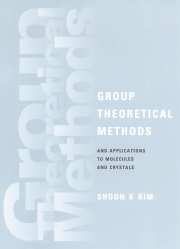Book contents
- Frontmatter
- Contents
- Preface
- List of symbols
- 1 Linear transformations
- 2 The theory of matrix transformations
- 3 Elements of abstract group theory
- 4 Unitary and orthogonal groups
- 5 The point groups of finite order
- 6 Theory of group representations
- 7 Construction of symmetry-adapted linear combinations based on the correspondence theorem
- 8 Subduced and induced representations
- 9 Elements of continuous groups
- 10 The representations of the rotation group
- 11 Single- and double-valued representations of point groups
- 12 Projective representations
- 13 The 230 space groups
- 14 Representations of the space groups
- 15 Applications of unirreps of space groups to energy bands and vibrational modes of crystals
- 16 Time reversal, anti-unitary point groups and their co-representations
- 17 Anti-unitary space groups and their co-representations
- Appendix Character tables of the crystal point groups
- References
- Index
9 - Elements of continuous groups
Published online by Cambridge University Press: 12 November 2009
- Frontmatter
- Contents
- Preface
- List of symbols
- 1 Linear transformations
- 2 The theory of matrix transformations
- 3 Elements of abstract group theory
- 4 Unitary and orthogonal groups
- 5 The point groups of finite order
- 6 Theory of group representations
- 7 Construction of symmetry-adapted linear combinations based on the correspondence theorem
- 8 Subduced and induced representations
- 9 Elements of continuous groups
- 10 The representations of the rotation group
- 11 Single- and double-valued representations of point groups
- 12 Projective representations
- 13 The 230 space groups
- 14 Representations of the space groups
- 15 Applications of unirreps of space groups to energy bands and vibrational modes of crystals
- 16 Time reversal, anti-unitary point groups and their co-representations
- 17 Anti-unitary space groups and their co-representations
- Appendix Character tables of the crystal point groups
- References
- Index
Summary
Introduction
An infinite group is a group that contains an infinite number of elements. The group axioms still hold for infinite groups. Among infinite groups, there are two categories: discrete and continuous ones. If the number of elements of a group is denumerably infinite, the group is said to be discrete, whereas if the number of elements is nondenumerably infinite, it is called a continuous group. For example, the whole set of rational numbers forms an infinite group that is discrete, whereas the whole set of real positive numbers is a continuous group. A continuous group G is a set of group elements that can be characterized by a set of continuous real parameters in a certain region called the parameter domain (or space) Ω such that there exists a one-to-one correspondence between group elements in G and points (the parameter sets) in the parameter domain Ω. For example, an element of the rotation group SO(3, r) = {R(θ)} is characterized by a set of three real parameters θ = (θ1, θ2, θ3) in the parameter sphere Ω of the radius π, i.e. 0 ≤ |θ| ≤ π with the cyclic boundary condition (see Equation (4.3.6)). In a continuous group G, the nearness of group elements is characterized by the nearness of their parameters in Ω. Thus the neighborhood of a group element is characterized by the neighborhood of the corresponding parameter set.
- Type
- Chapter
- Information
- Publisher: Cambridge University PressPrint publication year: 1999

